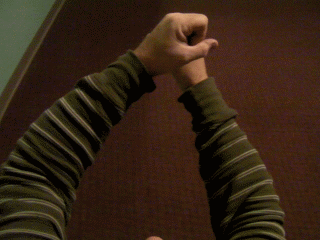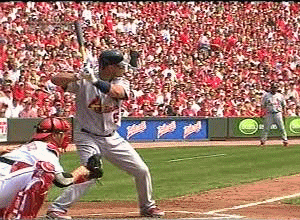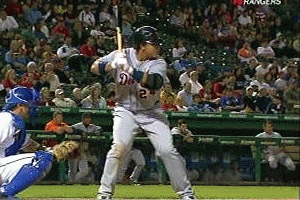First and foremost, the barrel must be launched by forearm rotation. When the forearms rotate, they applying a force 'into' the handle and cause it to rotate about the hands. I call the resulting hand action a swivel. The swivel is found in every high level hitter. The opposite, that is found in amateurs is the 'hammer'. If you put your elbow on a table and lift the hand so the forearm is vertical, and then rotate the two forearm bones about each other, you are rotating your forearms.....and your hand swivels. This concept, when done properly, REMOVES THE ARMS from the swing. By removing the arms, I mean the swinging of the arms, the pulling of the arms and the pushing of the arms. The arms do not act independently....other than when the forearms rotate. It also eliminates the pushing of the hands at/through contact....which is a hammering motion. And by hammering, I'm referring to exactly what it says....the action you would use to hammer a nail. Hammering action by the hands/forearms will never lead to the high level pattern. They are mutually exclusive.
Here is a clip of forearm rotation.

It is an overhead view of myself, a lefthanded batter. That action, is absolute. It must happen. And it must happen as quickly as you can do it. The launch of a high level swing is very very sudden. Forearm rotation is the only physical way the body can meet the demand of creating the suddenness necessary to hit well at high levels. It happens so quickly that it could be called a rearward 'flick' of the barrel....by way of the rotation of the forearms.
To get a good mental image of what is involved....you turn the barrel rearward so that it rotates about the rear forearm at 90 degrees. The rear forearm is the axle. The barrel path is the wheel. The bat would be the spoke. And the hand (top hand) swivels. Keep in mind that the forearms range of motion is limited....and this action will simply flatten the barrel....it won't take it all the way to contact. That will be discussed in a comment later.
The suddenness of the rearward 'flick'....which is an absolute....is what I call the uptick. The uptick is very counter-intuitive. You won't believe it until you try it. But that sudden rearward flick....done such that you 'launch and spend'....you go 'all in'....creates what I call 'auto-pilot'....for lack of a better word. What I mean by that is best described by slamming a door. You can slam a door in two ways. You can push it with your hand and keep contact with it and keep pushing all the way to the jam while maintaining contact. Or you can suddenly push it, create great speed, release it, lose contact with it, and allow it to go to the jam 'on it's own'. This second example is how the barrel is launched. That is what I call auto-pilot. Coasting might describe it....but coasting indicates it would be slowing down. It is not. The speed of the barrel would be similar to the speed of the baseball/softball just after you released it when throwing. You've released it....but it has great speed....max speed....in the first few frames of video after release.
Because you launched it rearward....because you created auto-pilot....because you aren't using your arms to generate speed....(the speed was created by the forearm rotation instantly....suddenly....when you rotated the forearms).....you have STARTED your swing....but you have not made a COMMITMENT to EXACT pitch location. It is going around a rearward arc that has a 'general' location goal that it will arc around to....but it is not fine tuned to a specific location. That happens after it circles the back of the arc....by the arms that are free to 'pull in' a bit or 'let out' a bit.
The barrel resembles a laso. You create the circling of the laso and then you release it....move it....to the steer's head. You create your hitting laso by upticking the barrel into a rearward arc....and then your arms are free to move/adjust the speeding barrel to the ball.
Here is a HUGE difference between high level and amateur swings. If you use hip rotation, if you use shoulder rotation, if you use PCR, if you use push/block/push, if you teach to move the hands forward before launching the swing.....you will always use your arms to either create or deliver the energy......DOWN THE LENGTH OF THE ARMS. When you create or deliver energy by any method that uses 'down the length of the arms and bat handle'....you have just eliiminated your ability to adjust to pitches. When your energy supply travels down the length of the arms and down the length of the bat by way of arm pull, arm push, rotation about the shoulders, rotation about the hips, a push/block/push.....you have to DEGRADE the speed of the barrel to adjust to a moving ball. You have to change the direction of the delivery and it will automatically degrade the speed if it is delivered 'down the length'. This means what most call 'connection'.....connection to a rotating body....so energy can be transfered down the length of the arms through the barrel to the barrel....is bogus.
All you have to do is stand up, get a bat, pull the knob in one attempt, and swivel the top hand by way of forearm rotation in a second attempt, and you will immediately feel the difference between a long swing and a short swing....both in length....and in time.
There is so much more to the purpose of the rearward barrel turn. That action is a major player in creating the overlap because the first two frames of rearward barrel launch....is also stretch. That's right. The first two frames of UNLOADING....is also....LOADING.
Experiment with what is written here.
I will add more.
But here are two clips and a comment to think about as you experiment....


The first two frames of a 5 frame swing....is both loading and unloading....if it is reaward. And the resulting launch is exponentially more sudden than if not. When the barrel is launched rearward....the speed and direction and weight of that barrel provides extreme resistance against which the rear leg counters in an equal an opposite manner.
SnF enhanced.

If you are applying force at contact...into the ball at contact.....your swing is not high level.
You never reached autopilot.
Bank on it.
HI.com will teach you how.
Not only a slowly moving barrel....but a barrel completely blurred out due to it's speed.....IS NOT COMMITTED IF IT IS LAUNCHED REARWARD.
As I've proven above.
I say proven. It has been proven to anyone and everyone who will let it be proven to them. Those who swing to duplicate hitters movements know the truth. The others, including Mr. Huff.....are simply guessing.
Shouldn't there be some kind of truth detector on these message boards?
I guess he hasn't read his own posts. You know, his arrogant attempts to shove his crap down our throats. Poor little man. You know, all those strawman arguments he created because his ego insisted he was the smartest man on the board.
He got out bullied. Never happened to him before. You know what bully wins on a discussion board? The bully who carries the truth. Our information was so damn good he has no choice but to succumb.
It's you own damn fault that we had to beat you like a drum to get you to listen.
The truth wins again. Always does.
The only question is how long will you fight the truth. Will you do it until your son's/daughter's/student's window of opportunity closes?